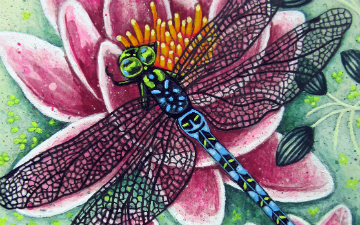| Dragonfly | |
|---|---|
 |
|
| Yellow-winged Darter | |
| Scientific classification |
|
| Kingdom: | Animalia |
| Phylum: | Arthropoda |
| Class: | Insecta |
| Order: | Odonata |
| Suborder: | Epiprocta |
| Infraorder: | Anisoptera Selys, 1854 |
| Families | |
A dragonfly is a winged insect belonging to the order Odonata, the suborder Epiprocta or, in the strict sense, the infraorder Anisoptera (from Greek ανισος anisos, “uneven” + πτερος pteros, “wings”, due the hindwing being broader than the forewing[1]). It is characterized by large multifaceted eyes, two pairs of strong transparent wings, and an elongated body. Dragonflies are similar to damselflies, but the adults can be differentiated by the fact that the wings of most dragonflies are held away from, and perpendicular to, the body when at rest. Dragonflies possess six legs (like any other insect), but most of them cannot walk well. Dragonflies are some of the fastest insects in the world.
Dragonflies are valuable predators that eat mosquitoes, and other small insects like flies, bees, ants, wasps, and very rarely butterflies. They are usually found around marshes, lakes, ponds, streams, and wetlands because their larvae, known as “nymphs“, are aquatic. Some 5680 different species of dragonflies are known in the world today.[2]
Dragonfly <== Click here to watch
Flight speed
Tillyard claimed to have recorded the Southern Giant Darner flying at nearly 60 miles per hour (97 km/h) in a rough field measurement.[3] However, the greatest reliable flight speed records are for other types of insects.[4] In general, large dragonflies like the hawkers have a maximum speed of 10–15 metres per second (22–34 mph) with average cruising speed of about 4.5 metres per second (10 mph).[5]
http://en.wikipedia.org/wiki/Dragon_fly




